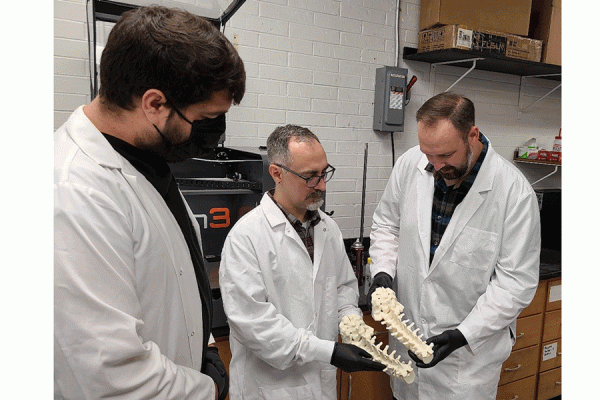University of New Orleans researchers, in collaboration with the Ochsner Medical 3D Lab, have developed new materials that effectively mimic the X-ray transparencies of bone and human tissue. Such materials are important because doctors can use them as tools for essential training in X-ray imaging and delicate surgical procedures.
Damon Smith, an assistant professor in the Department of Mechanical Engineering and the Advanced Materials Research Institute and UNO engineering graduate students John Arnold, Cory Darling and Bradley Sciacca, have teamed with Dr. Korak Sarkar, a neurologist from the Ochsner Medical 3D Lab, to develop methods and materials for the production of the various 3D structures.
Working directly from CT scans of patient anatomy, highly detailed medical training models, such as human spines, can be formed. The goal of this research is to advance personalized health care and training through the development of cutting-edge 3D visualization, manufacturing methods and materials.
“This multidisciplinary approach between Professor Damon Smith's lab and Ochsner Information Services’ medical 3D lab has the potential to augment medical education, improve clinical care delivery and exemplifies the cutting-edge research being done at the intersection of additive manufacturing and healthcare within our local ecosystem,” said Dr. Sarkar.
3D visualization is critical to the training of engineers and doctors in the medical field, Smith said.
“The ability to mimic internal human structures will further methods, producing more highly skilled professionals,” Smith said. “Beyond skeletal and tissue models, the research team is working to reproduce the pliability of human skin and subdermal tissues so that doctors can better practice invasive techniques, minimizing discomfort to patients.”
The work of Smith and Sarkar, along with UNO engineering graduate student John Arnold was recently published in the Journal of Biomedical Materials Research, Part B titled “3D Printed Bismuth Oxide-Polylactic Acid Composites for Radio-Mimetic Computed Tomography Spine Phantoms.”
“Building on this technology, we hope to construct self-healing tissue mimics so that researchers will be able to repeatedly use models in, for example, training on executing lumbar punctures, also known as spinal taps,” Smith said.





